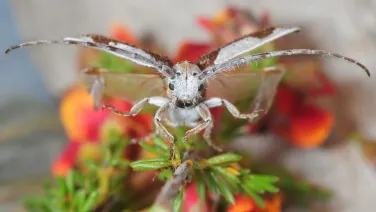
Never belittle the beetle: exploring the vast world of entomology with Yun Hsiao
While out strolling in nature, most of us don’t notice the miniscule flying insects around us. We swat them out of the way in annoyance – if we spot them at all.
But Dr Yun Hsiao is different. He’s been known to spontaneously reach out his hand to grab a passing beetle.
“When I do that, my friends think it’s crazy,” Dr Hsiao laughs.
As an entomologist, Dr Hsiao knows that gently catching a flying insect is the best way to identify it. They are just so small and so quick that it is easy for them to whizz by unnoticed, he says. But that’s part of the attraction: in the insect world there’s so much to learn.
There are likely entire families of insects that have never been studied by science, let alone millions of unnamed individual species. And quite a few of them are sitting in museum drawers all over the world waiting to be investigated.
When Dr Hsiao started his PhD research by looking at a group of Australian weevils, he and his joint supervisors from the ANU Research School of Biology and CSIRO had no idea what they might find.

“People don't know what the outcome will be. So after we do this kind of research, maybe it's not a perfect conclusion, but at least we know some stories from these results,” Dr Hsiao says.
Dr Hsiao's research explored the evolutionary relationship between pollinating weevils and an ancient group of plants called cycads.
This work took him on insect-collecting field trips to far north Queensland and the south coast of New South Wales. He also delved into archived insect collections from all over Australia and the world, piecing together an evolutionary history of the cycad weevils.
Back in the lab in Canberra, Hsiao spent many hours peering at beetle private parts under microscopes to identify species.
“You can find some characteristics from the external appearance. But I will say, genitalia is one of the key characteristics for identifying species,” he says. (The things we do in the name of science.)
Also using genetic analysis and comparing the evolutionary lineages of the cycads and weevils, he found that cycads and their pollinating weevils likely evolved independently of each other. Hsiao was also able to describe and name eight species of weevil, two of which have been published so far.

This is not the first time he’s classified new species previously unknown to science, the most memorable being three beetle species that he came across while writing a chapter for a book on Australian beetles. He named these brightly coloured rare beetles after Pokémon, the pop culture phenomena that inspired his own pursuit of science: Articuno, Moltres, and Zapdos.
“I wanted the Pokémon connection to raise people's awareness of these three new species,” he says. It worked, with global publications including USA TODAY, Forbes and The Guardian covering the story.
When it comes to insects, even those with funny names, you never know when information about them may become critically important.
“We know that climate change is gradually changing the world, including the insect world, so there are new agricultural pests and medical threats emerging. And when this happens, you need to know the name of the species to do any further research,” Dr Hsiao says.
“Also, as pollinators, insects like these weevil species can help to protect endangered plants, so it’s important we save the weevils as well.”
It’s a funny contradiction: for such tiny creatures, their scale and impact is humungous. The sheer number of unknown species out there, and their role in our ecosystem, is hard to fathom.
Next time Dr Hsiao grabs at a passing beetle from mid-air, who knows what he’ll discover.
Do you want an unbeweevable job? Look into a Bachelor of Science.



